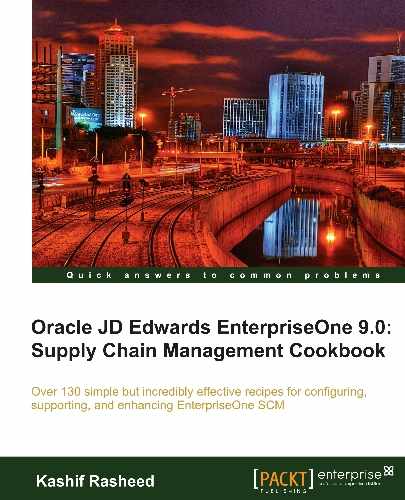This recipe demonstrates setting up a Purchase Order activity rule and the Purchase Order application processing options. You need to set up a Purchase Order rule for each individual item or service that you enter on a purchase order, and you must enter a line of detailed information that describes the order, including the quantity and cost of the item or service. You must set up order activity rules to establish the sequence of steps through which you progress. The Order Activity forces users to follow the same sequence that was specified in the the Order Activity set-up.
You should set up the order activity rule for the Purchase Order application in order to set up the processing options for Purchase Order application P4310.
- Set up the Order Activity Rule for Purchase Requisition via the G43A41 menu.
- Enter the Document Type for purchase orders as OP, and the Line Type as S.
- Enter the Order Activity for Purchase Order; the following screenshot shows the standard purchase requisition Order Activity Rule:

- Select Procurement and Subcontract Management | Daily Processing | Stock Based Purchasing | Purchase Order Processing, click the arrow next on Enter Purchase Order (P4310), and then select Values.
- Enter Order Type OP in the Order Type field in the Default tab. See the Order Activity rule set up screenshots, shown earlier.

- Enter Beginning Status 220 in the Default tab that exists in the Activity/Status Codes (40/AT) UDC to specify the default value for the beginning status for the order. The value that you enter must be set up for the Order Type and the Line Type.
- On the Order Inquiry tab, enter 220 in the From Status Code field, and 999 in the Thru Status Code field.
- Enter a value that exists in the Unit of Measure (00/UM) UDC to specify the default Unit of Measure that the system displays in the Transaction Unit of Measure field.
- Enter a whole number that the system uses to automatically increment the order lines on the order.
- On the Interface tab, leave the Business Unit Validation, PBCO Warning, PACO Warning, and Quantity Update fields blank, as shown in the following screenshot. These are the recommended settings for the Purchase Order application.

- On the Order Revision tab, specify whether the system allows revisions to an order. Enter 1 in the Processing Option.
- Specify the Next Status Code at which the system begins tracking order revision audit information. The system does not record revisions to a detail line if the line's status precedes the status code that you enter in this Processing Option. The system stores revision information in the P.O. Detail Ledger File - Flexible Version (F43199). You can access this table through the Order Revision Inquiry program (P4319).
- Specify whether the system allows you to enter text when you are entering a revision.
The system populates the Order Type field of the Order Header form with the order type processing option for the P4310 application. When you set up the Line Type in the processing options, the systems affects with the transaction interfaces (General Ledger, Job Cost, and Accounts Payable) based on line type setup. The Line Type also specifies the conditions for including a line on reports and in calculations. You define line types in the Order Line Types program (P40205). The value that you enter must be set up for the order type and the line type that you are using.
The system gets the next status codes for combinations of order type and line type by using the Order Activity Rules program (P40204). When you leave this processing option blank, the system uses the Next Status code in the Order Activity Rules as the default value.
The system uses the Purchasing Unit of Measure from the F4101 table. The transaction unit of measure directly relates to the number that you have entered in the Quantity field on the Purchase Order Entry form. If you select an item from a catalog in Purchase Order Entry, the unit of measure in the catalog overrides the value that you enter in this field. If you have entered a value in the Unit of Measure field, you should not enter a value in this field.
The system hides cost information. The cost field does not appear, although the system still writes the cost information to the F4311 table. The system uses cost information from the cost tables as the default. Examples of the cost tables are the F4105 table and the F41061 table. The cost table that the system uses for the default information depends on the way that the system is set up.
The system also validates the branch/plant against the F0006 table. Typically, you use this Processing Option when you are performing services expenditure purchasing. When you leave this processing option blank, the Ship To address book number from the address book number in the F0006 table is used. You can access the Business Unit Master table through the Revise Business Unit (P0006) program.
Using the Processing Options for Order Entry, you can display a header form before the detail form. Depending on how you set the Processing Options, certain fields can display on the header form. If you bypass the header form, you must enter limited header information on the detail form. Based on the supplier and branch/plant that you enter, the system applies default values to the fields on the header form.
